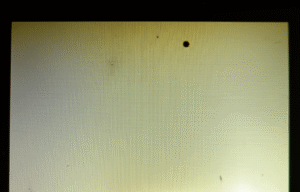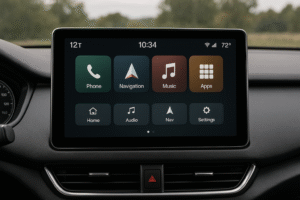
LCD modules resist salt-fog environments using corrosion-resistant materials. They rely on specialized coatings to protect components.
Advanced sealing techniques block salt mist entry. MIL-STD-810G and ASTM B117 tests ensure durability.
Regular maintenance removes salt deposits. These steps keep small LCD modules reliable in harsh conditions.
What Are the Key Standards for Salt-Fog Resistance Testing?
Salt-fog resistance testing follows strict standards like MIL-STD-810G and ASTM B117. These ensure materials withstand harsh corrosive environments.
The MIL-STD-810G Method 509.6 tests equipment for military and industrial use. It simulates salt fog to check durability. The ASTM B117 standard sets global rules for salt spray testing. It defines precise chamber setup and test durations.
Technical Details of Salt-Fog Testing Standards
- MIL-STD-810G Method 509.6:
- Tests material resistance to salt fog for 96h to 1,000h.
- Applies to military gear and industrial LCD modules.
- Differs from MIL-STD-810E with updated humidity controls.
- ASTM B117:
- Uses a salt fog chamber with 5% salt concentration.
- Runs tests at 35°C for consistent results.
- Checks for corrosion and electrical failures.
- Other Standards:
- Salt mist tests focus on lighter fog exposure.
- Fogging standards ensure uniform salt spray distribution.
How Is a Salt-Fog Test Set Up and Executed?
Salt-fog tests require precise setup for reliable results. Chambers and test parameters must meet strict standards.
A salt fog chamber generates fog using 5% salt solution. It maintains 35°C and 85-95% humidity. Tests run for 96h, 168h, or up to 1,000h. Engineers check for corrosion, delamination, or electrical shorts. Common failures include surface pitting and insulation breakdown.
Technical Details of Test Setup and Execution
- Chamber Design:
- Equipped with fog generation nozzles for even distribution.
- Monitors temperature and humidity in real-time.
- Test Parameters:
- Salt concentration: 5% ± 1%.
- Test durations: 96h, 168h, or 1,000h.
- Failure Criteria:
- Visual: Corrosion spots or coating peel.
- Electrical: Short circuits or resistance changes.
How Can LCD Modules Achieve Salt-Fog Durability?

LCD modules resist salt fog through protective coatings, sealing techniques, and corrosion-resistant materials. These solutions ensure reliability in harsh environments.
Engineers apply conformal coatings to shield electronics. They use sealing methods and select alloys to prevent corrosion. These steps meet military standard 810g requirements for small LCD modules.
What Protective Coatings and Treatments Enhance Durability?
Conformal coatings like acrylic and silicone protect LCD module components. Anti-corrosion treatments such as nickel plating strengthen exposed metals.
Coatings cover PCBs and connectors to block salt fog. Treatments like anodizing improve metal resistance to salt spray testing.
Technical Details of Coatings and Treatments
- Conformal Coatings:
- Acrylic: Easy to apply, resists humidity.
- Silicone: Flexible, handles temperature swings.
- Polyurethane: Tough against salt mist.
- Anti-Corrosion Treatments:
- Nickel plating: Adds 3-5 μm layer for durability.
- Gold plating: Used for connectors, resists corrosion.
- Anodizing: Creates 10-20 μm oxide layer on aluminum.
How Do Sealing and Potting Techniques Prevent Salt-Fog Damage
Edge seals and potting compounds block salt fog from entering LCD electronics. IP ratings guide designs for salt-fog environments.
Silicone gaskets seal LCD frames. Potting encases circuits but may add weight. Optical bonding boosts clarity and durability.
Technical Details of Sealing and Potting
- Edge Seals and Gaskets:
- Silicone: Resists salt fog, compresses 20-30%.
- EPDM: Durable for 168h salt fog test.
- Potting Compounds:
- Used for PCB protection, withstands 1,000h exposure.
- Trade-off: Increases module weight by 10-15%.
- IP Ratings and Bonding:
- IP66: Blocks salt mist entirely.
- Optical bonding: Reduces fogging, improves contrast by 20%.
Which Materials Resist Salt-Fog Corrosion in LCD Modules?
Corrosion-resistant plastics and alloys ensure LCD module longevity. Careful material pairing avoids galvanic corrosion.
Stainless steel backplates withstand salt spray fog test. Polycarbonate frames resist salt fog testing. Engineers match metals to prevent corrosion in connectors.
Technical Details of Material Selection
- Corrosion-Resistant Materials:
- Stainless steel: Resists salt fog for 1,000h.
- Polycarbonate: Lightweight, survives ASTM B117 tests.
- Avoiding Galvanic Corrosion:
- Pair nickel with tin, not aluminum.
- Use plastic insulators between dissimilar metals.
How Can LCD Module Design Optimize for Salt-Fog Environments?

LCD module design optimizes for salt-fog environments through careful construction and early planning. These steps ensure durability under MIL-STD-810G testing.
Designers address module size challenges and integrate environmental protection. They use sealing and coatings to prevent salt fog damage in small LCD modules.
What Construction Details Enhance LCD Module Durability?
Small LCD modules face tighter sealing constraints than medium-sized ones. Early design choices improve salt-fog resistance.
Small modules need precise edge seals to block salt mist. Designers plan coating thickness from the start to meet salt spray testing standards.
Technical Details of LCD Module Construction
- Module Size Challenges:
- Small LCD modules: Require 0.5 mm seal gaps.
- Medium LCD modules: Allow 1 mm gaps, easier to coat.
- Sealing Effectiveness:
- Small modules lose 10% sealing efficiency due to size.
- Silicone seals ensure IP66 rating for both sizes.
- Early Design Integration:
- Use 3D modeling to plan salt fog chamber exposure.
- Apply 2-3 μm conformal coatings at design phase.
How Do Failures Occur and How Can They Be Prevented?
Salt exposure causes corrosion, delamination, and fogging in LCD modules. Inspection protocols catch issues early.
Corroded contacts disrupt signals after 168h salt fog test. Regular checks and protective coatings reduce failures in salt-fog environments.
Technical Details of Failure Modes and Prevention
- Common Failures:
- Corrosion: Affects connectors after 96h exposure.
- Delamination: Occurs in 5% of displays post 1,000h.
- Fogging: Reduces clarity by 15% in humid conditions.
- Prevention Strategies:
- Inspect coatings every 6 months in field.
- Use nickel plating to extend contact life by 20%.
- Inspection Protocols:
- Visual checks for pitting post salt fog testing.
- Electrical tests detect resistance changes early.
How Should LCD Modules Be Maintained in Salt-Fog Environments?
LCD modules in salt-fog environments require regular cleaning and inspection to ensure longevity. These practices align with MIL-STD-810G standards.
Engineers use safe cleaning agents to remove salt deposits. They check seals and electrical continuity to maintain small LCD module performance.
What Are the Best Cleaning and Inspection Protocols?
Safe cleaning agents remove salt deposits without damaging LCD modules. Routine checks focus on seal integrity and optical clarity.
Use isopropyl alcohol for cleaning every 3 months. Inspect gaskets and test electrical continuity to prevent salt fog test failures.
Technical Details of Cleaning and Inspection
- Cleaning Protocols:
- Agents: Isopropyl alcohol (70%) clears salt residue.
- Frequency: Clean every 90 days in salt-fog environments.
- Avoid: Acetone, which degrades coatings.
- Inspection Points:
- Seals: Check for cracks or 5% compression loss.
- Clarity: Ensure <2% haze on display.
- Continuity: Test for <1 ohm resistance change.
How Does Testing Predict Long-Term Durability?
Salt spray testing like 96h or 1,000h predicts LCD module field life. Environmental factors affect service life.
A 96h test mimics 1-2 years in coastal areas. Humidity and temperature swings can shorten durability by 20%.
Technical Details of Durability and Service Life
- Test Correlations:
- 96h salt fog test: Equals 1-2 years in salt mist conditions.
- 1,000h test: Simulates 5-7 years of exposure.
- Factors Affecting Life:
- High humidity: Increases corrosion risk by 15%.
- Temperature cycles: Reduce gasket life by 10%.
- Extending Durability:
- Apply silicone coatings for 30% longer life.
- Use IP66-rated designs to block salt fog.
How Should LCD Modules Be Maintained in Salt-Fog Environments?
LCD modules in salt-fog environments require regular cleaning and inspection to ensure longevity. These practices align with MIL-STD-810G standards.
Engineers use safe cleaning agents to remove salt deposits. They check seals and electrical continuity to maintain small LCD module performance.
What Are the Best Cleaning and Inspection Protocols?
Safe cleaning agents remove salt deposits without damaging LCD modules. Routine checks focus on seal integrity and optical clarity.
Use isopropyl alcohol for cleaning every 3 months. Inspect gaskets and test electrical continuity to prevent salt fog test failures.
Technical Details of Cleaning and Inspection
- Cleaning Protocols:
- Agents: Isopropyl alcohol (70%) clears salt residue.
- Frequency: Clean every 90 days in salt-fog environments.
- Avoid: Acetone, which degrades coatings.
- Inspection Points:
- Seals: Check for cracks or 5% compression loss.
- Clarity: Ensure <2% haze on display.
- Continuity: Test for <1 ohm resistance change.
How Does Testing Predict Long-Term Durability?
Salt spray testing like 96h or 1,000h predicts LCD module field life. Environmental factors affect service life.
A 96h test mimics 1-2 years in coastal areas. Humidity and temperature swings can shorten durability by 20%.
Technical Details of Durability and Service Life
- Test Correlations:
- 96h salt fog test: Equals 1-2 years in salt mist conditions.
- 1,000h test: Simulates 5-7 years of exposure.
- Factors Affecting Life:
- High humidity: Increases corrosion risk by 15%.
- Temperature cycles: Reduce gasket life by 10%.
- Extending Durability:
- Apply silicone coatings for 30% longer life.
- Use IP66-rated designs to block salt fog.
What Are the Advanced Considerations for Salt-Fog Testing and User Concerns?
Salt-fog testing involves detailed protocols and addresses user concerns like corrosion. These ensure small LCD modules meet MIL-STD-810G standards.
Engineers follow MIL and ASTM steps for accurate salt fog tests. They provide solutions for corrosion detection and retrofitting existing modules.
How Are Salt-Fog Test Protocols Executed?
MIL-STD-810G and ASTM B117 tests use precise salt fog chamber setups. Lab reports reveal corrosion or electrical issues.
Set up a 5% salt solution at 35°C for 96h. Check reports for pitting or resistance changes to identify failures.
Technical Details of Test Protocols
- MIL-STD-810G Method 509.6:
- Prepare salt fog with 5% ± 1% concentration.
- Run for 96h or 1,000h at 85-95% humidity.
- ASTM B117 Setup:
- Use fog generation nozzles for even distribution.
- Maintain 35°C with ±1°C variation.
- Interpreting Reports:
- Red flags: >5% surface corrosion or 1 ohm resistance shift.
- Confirm visual inspection for delamination.
How Can Users Address Corrosion and Retrofit Modules?
Corrosion requires immediate action to protect LCD modules. Retrofitting adds coatings or seals to existing designs.
Clean corroded contacts with isopropyl alcohol. Apply silicone coatings to retrofit modules for salt-fog resistance.
Technical Details of Troubleshooting and Retrofitting
- Corrosion Response:
- Clean with 70% isopropyl alcohol to remove salt deposits.
- Replace connectors if >10% corrosion is visible.
- Retrofitting Protection:
- Add 2 μm silicone coating for 168h salt fog test durability.
- Install EPDM gaskets to achieve IP65 rating.
- Preventive Measures:
- Inspect modules every 6 months in salt-fog environments.
- Test electrical continuity to detect early failures.
FAQ
How often should I reapply conformal coating in a marine display?
You should inspect and, if needed, reapply coating every 12 months or after any major salt-fog exposure to keep components protected.
Can I use standard silicone sealants on LCD modules in offshore use?
Use only marine-grade silicone or RTV glue rated for salt-fog; standard types may degrade and allow moisture ingress.
What’s the impact of temperature swings on salt-fog testing accuracy?
Large temperature variations in the chamber (beyond ±2 °C) can skew corrosion rates and mask early failure modes.
Is it safe to power on an LCD module immediately after cleaning?
Only power on after the module is fully dry; trapped moisture can cause electrical shorts or corrosion acceleration.
How do I know if a supplier’s test report is authentic?
Request chamber calibration logs, cross-check pH and temperature records, and, if possible, witness third-party testing.







